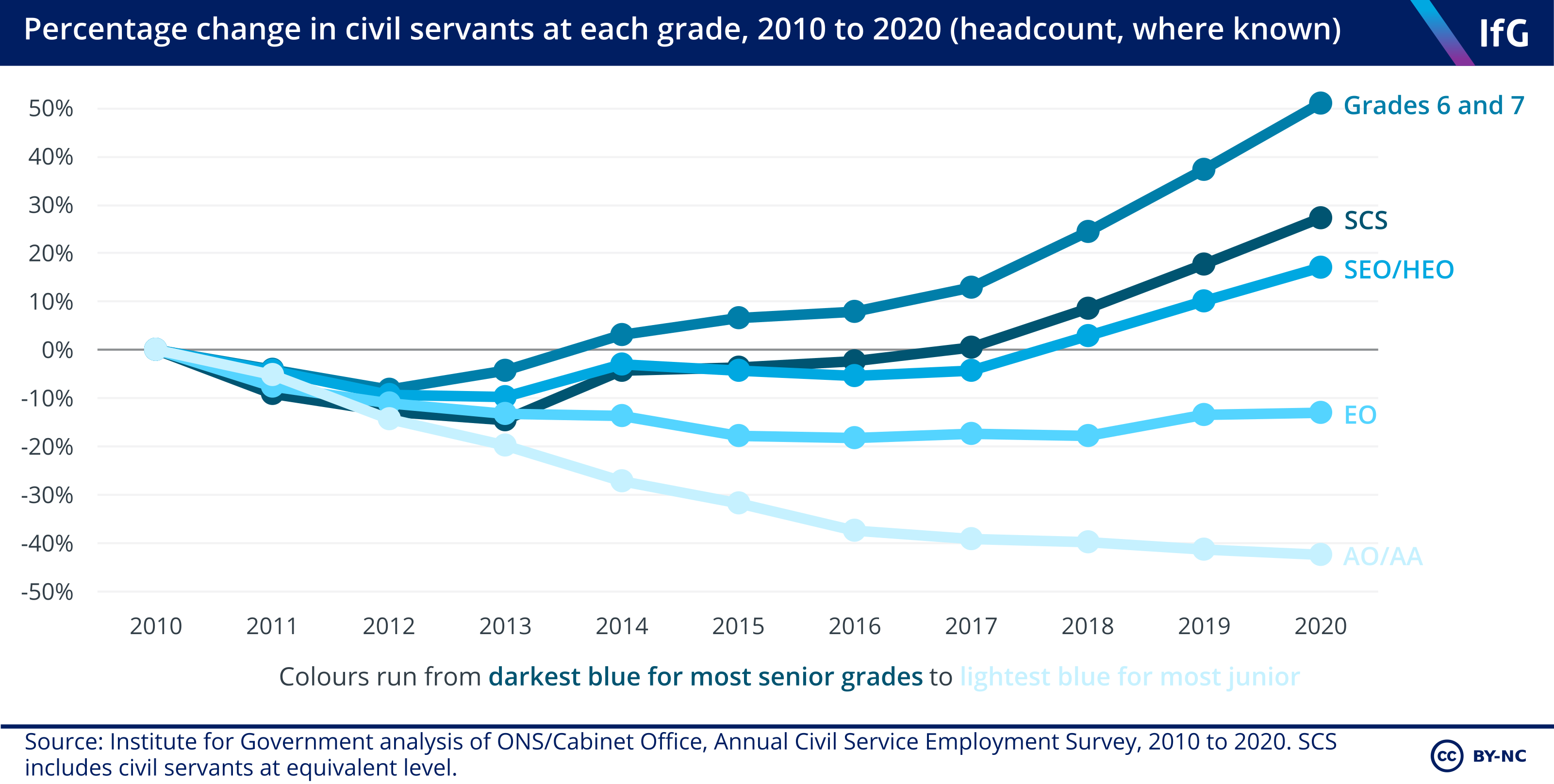Grade structures of the civil service
Broadly, there are five civil service job grades. We explain what they are and how civil service grade composition varies by department.

How are civil service jobs graded?
Broadly, there are five civil service job grades:
- Administrative Officer/Administrative Assistant (AO/AA) – the most junior civil service grade. These roles tend to comprise administrative support and operational delivery roles, such as prison officers and caterers.
- Executive Officer (EO). Civil servants in this grade offer business and policy support and include roles such as executive assistants, finance, HR, IT and communications specialists.
- Senior Executive Officer/Higher Executive Officer (SEO/HEO) includes policy officers and officials with specific policy responsibilities.
- Grades 6 and 7 civil servants tend to be experienced officials with significant policy responsibilities.
- Senior Civil Service (SCS) is the most senior grade of the civil service made up of the senior management team. Generally, directors are ultimately responsible for the policy work of their team and director generals oversee directors and work closely with the department’s ministers. Each department also has a permanent secretary as part of the SCS who supports the minister at the head of the department, acts as the accounting officer and is responsible for the day-to-day running of the department.
The civil service does not actually publish any details of its grade structure; the graphic below was put together following a hack day using government organograms.

Are there standard job titles in the civil service?
Job titles vary across departments and functions. Grades should offer a consistent way of understanding seniority across all departments. However, in practice, this is not the case – as our table shows, departments often categorise grades differently.
Band names in the senior grades of the civil service have also changed over time. 6 Stanley M, Civil Servants - Grades & Roles, civilservant.org.uk, www.civilservant.org.uk/information-grades_and_roles.html
What is the grade composition of the civil service?

Despite disproportionate staff cuts at lower grades, the civil service is still largely comprised of people at the AO/AA and EO grades.
In 2010, AO/AAs, made up of nearly half (47%) of the civil service workforce. Although it is still the largest grade in the civil service, AA/AOs now make up around a third of the workforce (32%). The proportion of EOs has remained broadly flat at around 26% (although actual headcount has fallen), while SEO/HEOs and Grades 6 and 7 make up a much greater proportion of the civil service now than in 2010.
The SCS, the most senior grade, makes up 1.5% of the whole civil service.
How does civil service grade composition vary by department?

Big ‘delivery’ departments (departments with major operational delivery functions) tend to have more staff at junior levels, making them more ‘pyramid-shaped’. For example, AO/AAs make up 62% of MoJ civil servants (which include prison officers). HMRC, HO, and DWP are other examples of bottom-heavy departments.
Departments with the bulk of staff employed as SEO/HEOs are ‘diamond-shaped’, such as Defra, MHCLG, and DfE. This may be a result of digitalisation 8 Foster M, HMRC chief Lin Homer looks to "diamond-shaped" future for department, Civil Service World, 9 September 2015, www.civilserviceworld.com/professions/article/hmrc-chief-lin-homer-looks-to-diamondshaped-future-for-department reducing demand for administrative staff in departments that don't have significant operational delivery functions.
Between 2017 and 2018, the grade balance in the Cabinet Office changed significantly due to the Civil Service Resourcing and the Fast Stream moving to the department from HMRC. This resulted in a large increase in the number of SEO/HEOs.
BEIS, DCMS, and HMT are top-heavy departments, which have a larger percentage of civil servants employed at more senior grades. These tend to be smaller, more policy-focused departments without major operational delivery functions. Counter-intuitively, these departments also tend to be among the youngest departments in Whitehall in terms of age composition.
All departments (except those newly created in 2016) have seen the proportion of staff at the most junior AO/AA grade fall since 2010. The percentage of staff employed at Grades 6 and 7 has increased in every department, and the percentage of SEO/HEOs has increased in almost every department.
How has the number of civil servants in each grade changed over time?

Cuts in the total number of civil servants have not been spread evenly across grades. In fact, there are now 51% more staff at Grades 6 and 7 than in 2010, with SCS numbers increasing by 27% and SEO/HEO numbers increasing by 17%.
However, the two most junior grades have experienced a net reduction, with staff numbers falling by 42% at the AO/AA level and by 13% at the EO level. AO/AA is the only grade to experience a reduction in every year since 2010.
How does civil service morale vary by grade?
The chart and text below are based on data from 2018, as the Civil Service People Survey 2020 has not been released.

The Civil Service People Survey, in which 300,000 civil servants answered more than 60 questions during October 2018, is a key indicator of organisational health. A higher engagement score indicates higher satisfaction.
Senior grades are generally more satisfied than junior grades. Across all the themes measured in the Survey, the SCS is the most satisfied, and usually by a significant margin.
The biggest difference between satisfaction in the SCS and other grades is for ‘leadership and managing change’, with a 32 percentage point difference between how well AO/AA staff and SCS staff believe their department is being led.
Satisfaction tends to fall as grades become more junior. ’Resources and workload’ is, however, an exception to this rule: as well as being more satisfied than AO/AAs, EOs are more satisfied than SEO/HEOs, and Grades 6 and 7. SCS satisfaction still outstrips all other grades.
Whitehall Monitor 2024
Our annual, data-based assessment of the UK civil service
- Topic
- Civil service
- Keywords
- Civil servants Civil service reform
- Department
- Cabinet Office
- Publisher
- Institute for Government